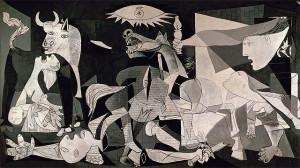
In 1969 the Art Workers Coalition, a collective of New York artists, writers and cultural producers, independently published the iconic anti-war poster And babies? Some 50,000 copies were privately funded by the Art Workers Coalition and printed by the New York City Lithographers Union after Museum of Modern Art trustees Nelson Rockefeller and William S. Paley deemed it “outside the function of the museum” and revoked project support. It depicts U. S. combat photographer Robert Haeberle’s image of women and children killed by American soldiers during the March 1968 My Lai Massacre, overlaid with text quoted from a television interview between journalist Mike Wallace and U. S. soldier Mike Meadlo. It is one of the most powerful and widely recognized anti-war images of its era — and among the most graphically violent. Its resonating social impact demonstrates the undeniable moral force of images when they reveal the truth. Though but one example in a long history of artists who confront social injustice, the poster is among the most important examples of our time because it also speaks to the power of individuals to autonomously bypass commercial media and institutional support/restraints. And babies? didn’t just change minds about the American War in Vietnam, it changed minds about the political empowerment of individuals and their potential reach.

The rapid development of technology has enabled a kind of instantaneous activism today that would have been inconceivable until very recently. With it we have seen the rise of a global public network that has formed new strategies of community. Each iteration has its own code of conduct, from Facebook to Twitter to LinkedIn to Instagram. Public opinion is often a matter of instantaneous record and polling is done by shared images. (See Facebook map (above) detailing the recent adoption of an equal sign expressing solidarity for gay marriage, posted via ABC News, on March 29, 2013.) Consensus is now gathered by #hashtags and shared posts, among other Internet protocols — all of which are profoundly well-suited to bearing witness en masse, as a global community.
Amongst a certain old guard, there is often the need to debate the potency of online activism versus on the ground action. This is often foregrounded by the insistence that “revolutions happen in the flesh” and thereby can’t be replicated in social media, as New York Times critic Michael Kimmelman recently wrote of the current protests in Turkey. But this notion does not allow for the modern paradigm of dispersed communities or the impact of world opinion. This was illuminated by the social media response to the illegal detention of Chinese artist and activist Ai Weiwei in Beijing in 2011. The overwhelming international online reaction is largely credited with saving his life, which demonstated that attention — persistent attention from multiple sectors — can be leveraged to affect political change.
To consider this, lets return to Turkey. On May 27, 2013 people gathered in Istanbul to peacefully demonstrate against the proposed development of Gezi Park, the district’s last remaining green public space, following the Turkish Prime Minister Tayyip Erdogan’s announcement of plans to raze the park to build a shopping mall designed after Ottoman-era army barracks. The protest was organized in the same vein as the worldwide Occupy movement: the occupation housed a free library, music concerts, and yoga, among other peaceful community activities. Demonstrations quickly spread to Turkish cities beyond Istanbul and all were met with violent government opposition within a matter of days. As of June 24, the Turkish Medical Association has reported 8,038 people injured, with multiple cases of severe head trauma and loss of sight. Several protestors have died.

In the midst of the violence of June 17, Erdem Gundüz, a Turkish choreographer and performance artist, took to the square in a gesture of silent protest that confounded police and cleverly evaded a ban against gatherings: he simply stood silently for hours and stared up at a portrait of secular Turkish leader Mustafa Kemal Ataturk, positioned above the cultural center. The gesture immediately went viral. While some joined him in solidarity, including many in other cities, others distributed images on Twitter under #duranadam (Duran adam means “standing man.”); for a time, it was the top Twitter trend worldwide.
Though this gesture, this standing man, did not resolve unrest in Turkey, the images served to draw further international attention to the extreme violence visited upon the Turkish people. More international leaders have begun questioning the Turkish government. (This is where secondary protest — objections from elsewhere — is particularly effective: Noise rises as it increases.) The action in real life and its replication in social media powerfully demonstrate the role of the individual in cultivating agency against injustice. One could even argue that the replication mattered equally to the act itself.
It also speaks to the astonishing power of social media to draw international attention to abuses of power, often in real time. “This is happening now” is frequently posted on my Facebook feed accompanied by a live feed of action, be it a standing man or a filibustering woman — thanks to social media, global politics play out on the world stage, twenty-four hours a day. Individuals, artists or otherwise, compelled to confront violence and inequity have all the resources they need to bear witness, and in doing so, possibly light the spark of a revolution. There is no one way to go about it — there is only the way forward, as history has shown.







